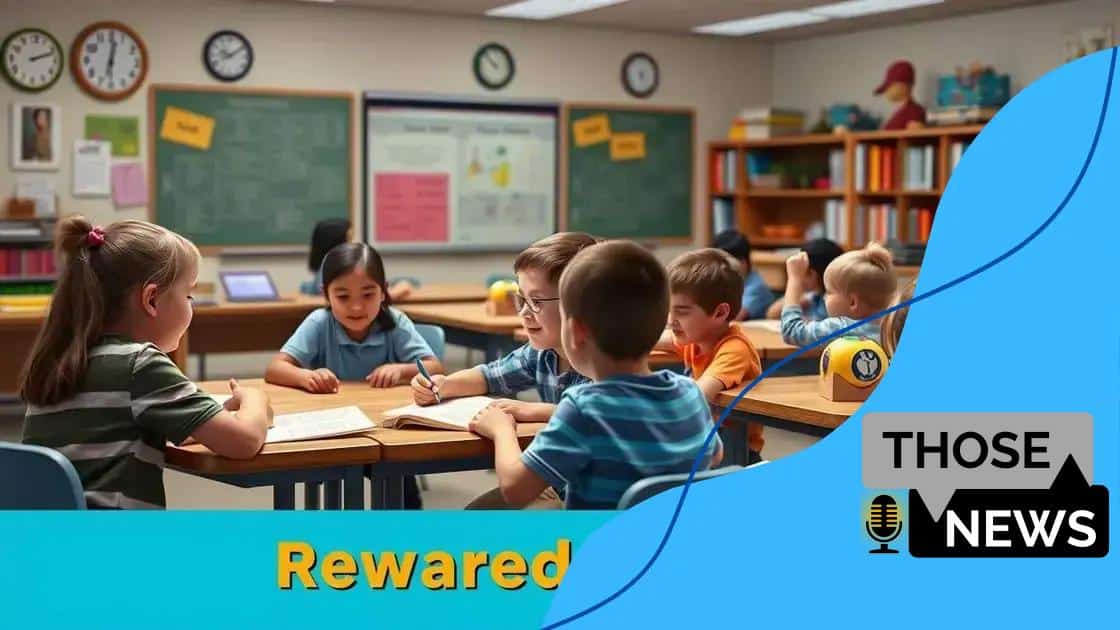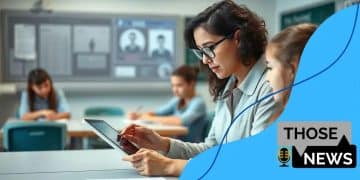Gamification to boost student engagement effectively

Gamification boosts student engagement by incorporating game elements like points and badges into learning, making it more interactive and motivating for students.
Gamification to boost student engagement is becoming a game changer in how we approach education. Have you ever wondered how playful elements can encourage learning? In this article, we’ll delve into what makes gamification so effective.
Understanding gamification and its principles
Understanding gamification is essential for educators looking to enhance their teaching methods. It combines game design elements with non-game contexts, especially in education. By applying gamification strategies, teachers can create a more interactive and engaging environment for students.
Key Principles of Gamification
At its core, gamification revolves around several key principles that drive engagement and motivation. These principles include:
- Points: Students earn points for completing tasks, which encourages competition and rewards effort.
- Badges: Visual representations of achievements that motivate students to strive for higher goals.
- Leaderboards: Public displays of student performance that create healthy competition.
- Challenges: Tasks designed to be tough yet achievable, pushing students to improve their skills.
By incorporating these elements, educators can motivate students to participate actively in their learning. The use of gamification can turn mundane tasks into fun challenges. Imagine students eagerly working on their math problems not just to finish, but to earn points and badges!
Another aspect of gamification is providing instant feedback. This type of feedback lets students know where they stand and how they can improve. For example, if a student completes an online quiz, they should receive immediate results. This encourages them to learn from their mistakes without delaying progress.
Benefits of Gamifying Education
The benefits of gamification extend beyond just making learning fun. Engaging students through game-like scenarios promotes critical thinking and problem-solving skills. This approach also caters to various learning styles, as students are more likely to remember information presented in an engaging manner.
Moreover, gamification fosters collaboration. Many gamified activities require students to work together, enhancing their teamwork skills. Thus, gamification is not just a trend; it is a powerful method for transforming our educational systems.
The psychological benefits of gamification
The psychological benefits of gamification have emerged as crucial components in educational settings. Engaging students with game-like elements can dramatically enhance their overall learning experience. One principle behind this is that gamification taps into intrinsic motivation, encouraging students to engage without external rewards.
Enhancing Motivation
Gamification enhances motivation by making learning more enjoyable. When students face challenging tasks within a game-like framework, they are often more willing to take risks and persevere. This can lead to greater confidence in their abilities.
- Increased participation: Students are more likely to participate when they feel that the activities are fun and rewarding.
- Sense of achievement: Earning points and badges gives students a tangible sense of accomplishment.
- Positive feedback: Game mechanics often include immediate feedback, making it easier for students to see their progress.
- Enhanced focus: Students find it easier to concentrate on tasks that engage them and align with their interests.
Moreover, when students experience success through gamification, it fosters a growth mindset. They begin to understand that effort leads to improvement. This mindset can propel them to tackle challenges head-on.
Another significant benefit of gamification is its ability to reduce anxiety around learning. Traditional assessments can create stress, but gamification shifts the focus from grades to learning. In a gamified environment, failure is seen as a chance to learn and try again, which can alleviate pressure on students.
Building Social Connections
Social interaction is another psychological benefit of gamification. Gamified activities often require collaboration among students, fostering teamwork and communication skills. These interactions can make learning more dynamic and enjoyable, as students engage not only with the material but also with each other.
Additionally, the competitive aspect of gamification can create a sense of community. As students work towards shared goals, they develop relationships that support their educational journey. Thus, gamification creates a more connected and supportive classroom environment.
Practical examples of gamification in education

Practical examples of gamification in education illustrate how effective these strategies can be in the classroom. By incorporating game elements, teachers make learning engaging and interactive. Let’s explore several effective practices that have enhanced educational experiences.
Interactive Quizzes and Competitions
One of the most popular ways to apply gamification is through interactive quizzes. Teachers can use platforms that allow students to compete in real-time. This method transforms a typical quiz into a fun competition where students earn points for correct answers, boosting their motivation to participate.
- Kahoot! – A game-based learning platform where students answer questions on their devices.
- Quizizz – Similar to Kahoot!, but it allows students to play at their own pace.
- Classcraft – A role-playing game that encourages collaboration while completing educational quests.
These tools show how gamification can turn learning into a thrilling race, igniting student enthusiasm.
Storytelling and Adventure Learning
Another effective application of gamification is through storytelling and adventure learning. Teachers can create narrative-based lessons where students become characters in a story. They complete challenges that relate to the subject matter. This approach not only makes the lessons enjoyable but also strengthens retention of the material learned.
For instance, in a history class, students could embark on a quest to uncover historical mysteries. They solve puzzles and complete assignments to unlock new chapters of the story. This sense of adventure creates a deeper connection with the content.
Reward Systems
Implementing a reward system is another practical example of gamification. Teachers can give out badges or certificates for reaching specific milestones. This motivates students to accomplish learning goals and encourages them to take ownership of their education.
- Digital badges: Recognition for completing tasks or projects.
- Leaderboards: Displaying top performers to inspire healthy competition.
- Challenge events: Organizing contests where students can earn rewards through achievements.
These systems reinforce positive behaviors and foster a sense of accomplishment among students.
Incorporating these practical examples of gamification into educational practices makes learning interactive and effective. When students actively participate, their engagement level rises, leading to better results.
Tools and platforms for gamification
Tools and platforms for gamification are essential for educators looking to enhance student engagement. Various options are available that can add game-like elements to lessons, making learning more interactive and fun. Let’s explore some of the most popular platforms and their features.
Kahoot!
Kahoot! is an interactive quiz platform that allows teachers to create engaging quizzes that students can participate in real-time using their devices. Its vibrant interface and competitive formats encourage all students to join in, making even the most reluctant learners eager to participate.
Quizizz
Another great tool is Quizizz. It lets teachers design quizzes where students can compete against each other while working at their own pace. This flexibility is crucial for accommodating different learning speeds, ensuring that all students stay engaged.
- Game mechanics: Offers points and leaderboards.
- Accessibility: Easy for students to join and use on any device.
- Customization: Teachers can create quizzes tailored to their lessons.
With Quizizz, learning becomes a fun competition that keeps students motivated to improve.
Classcraft
Classcraft takes gamification to a whole new level by turning the classroom into a role-playing game. Students create characters and work together to complete quests that align with their curriculum. This platform emphasizes collaboration and teamwork, making lessons more engaging.
Edmodo
Edmodo is another effective platform for teachers. While primarily a learning management system, it incorporates elements of gamification by allowing teachers to award badges and points for completed assignments and participation. This feature encourages students to stay active and engaged in their learning.
Badgr
Badgr is a platform that focuses specifically on digital badges. Teachers can create and award badges for various achievements, fostering a sense of accomplishment in students. Badgr integrates easily with many learning management systems, making it a valuable tool for any classroom.
Choosing the right tools and platforms for gamification can significantly impact the learning environment. By incorporating these resources, educators can transform their classrooms into interactive spaces that inspire students to learn and collaborate.
Measuring the effectiveness of gamification strategies
Measuring the effectiveness of gamification strategies is crucial for understanding how these methods impact student engagement and learning outcomes. Various techniques can help educators determine whether their gamified approaches are successful.
Data Analysis and Feedback
One way to measure effectiveness is through data analysis. Teachers can track student performance before and after implementing gamification. This comparison can reveal significant changes in engagement and achievement. Surveys and feedback from students are also valuable. They can provide insights into what elements of the gamified experience they enjoyed the most and what could be improved.
- Pre- and post-assessments: Compare student scores to gauge growth.
- Surveys: Collect student opinions on their learning experiences.
- Engagement metrics: Track participation rates and completion times for tasks.
By using multiple data sources, teachers can build a comprehensive picture of how gamification affects their students.
Observation and Interaction
Another effective method is direct observation. Teachers can note how students interact during gamified activities. Are they excited and engaged, or do they appear disinterested? These observations can complement data and feedback, helping to assess the real impact of gamification.
Additionally, analyzing classroom dynamics can provide insights. When students work together in competitive scenarios, do they collaborate effectively, or are there disruptions? Understanding these dynamics can help educators tweak their strategies for better engagement.
Long-term Performance Tracking
Long-term tracking of student performance is also essential in measuring the effectiveness of gamification. By comparing data over an extended period, educators can identify trends indicating whether gamification positively or negatively affects student learning in the long run.
Setting specific goals for each gamification strategy can facilitate this tracking. Teachers should define what success looks like, whether it’s improved scores, higher engagement, or student retention. This clarity will help in evaluating whether the implemented strategies have truly made a difference.
In summary, measuring the effectiveness of gamification strategies involves a combination of data analysis, observation, and long-term tracking. By using these methods together, educators can adapt and refine their approaches to maximize student engagement and learning outcomes.
FAQ – Common Questions about Gamification in Education
What is gamification in education?
Gamification in education involves using game elements like points, badges, and challenges to enhance student engagement and make learning more interactive.
How can I measure the effectiveness of gamification strategies?
You can measure effectiveness through data analysis, student feedback, and by tracking long-term performance to see if engagement and learning outcomes improve.
What tools are available for implementing gamification?
Popular tools include Kahoot!, Quizizz, and Classcraft, which provide platforms for creating engaging quizzes and activities that motivate students.
What are the psychological benefits of gamification?
Gamification enhances motivation, reduces anxiety, fosters collaboration, and promotes a growth mindset, helping students feel more engaged and confident in their learning.





